本文由 傅英斌工作室 授权mooool发表,欢迎转发,禁止以mooool编辑版本转载。
Thanks Fuyingbin Studio for authorizing the publication of the project on mooool, Text description provided by Fuyingbin Studio.
傅英斌工作室:候忠茂去世的时候不到二十岁,他是哪里人?有没有结婚?有没有兄弟姐妹?他的家人是否知道他的去世?这些事情我们都不得而知,这位小战士的墓就像贵州众多的长征红军墓一样,葬在了长征的路上。80多年前史诗一般的长征震惊世界,铸就了中国革命史上的不朽篇章,然而正是这些默默奉献了年轻生命的战士,才组成了这条地球上的红飘带。我们试图通过这一处普通而微小的的红军墓设计追述个体价值和反思历史的本真。
Fuyingbin Studio:When Hou Zhongmao died, he was less than twenty years old. Where is he from? Is he married? Does he have any siblings? Does his family know his death? None of questions we were able to answer. The cemetery of this young soldier is one example of many other cemeteries of the Chinese Red Army during their Long March in Guizhou province. He was buried on the road of the Long March. More than 80 years ago, the epic Long March shocked the world and created an immortal chapter in the history of the Chinese revolution. However, these soldiers who silently dedicated their young lives have formed the red ribbon on this earth. We try to trace the individual values and rethink the nature of history by designing this tiny cemetery of an ordinary red army’s soldier.
源起 Origin
贵州遵义桐梓县中关村地处深山,长征中著名的娄山关战役就在村子西南12公里处,娄山关战役中负责包抄的一支部队路过村子时一位生病的小战士被留在村中,淳朴的村民为红军战士送饭治病,不幸的是一年后小红军还是离开人世,负责为红军治病的村民把红军埋葬在自家山坡的田地之中。这座孤坟就这样在山坡上守候了80年,直至2016年新一轮的乡村建设人们再次注意到村里这处长征遗迹。
Zhongguan Village, Tongzi County, Zunyi City, Guizhou Province is located in the deep mountains. The famous Battle of Loushanguan during the Long March was 12 kilometers southwest of the village. An army who was responsible for the ambush in the battle of Lushanguan passed through the village while a sick young soldier was left in the village. The villagers gave food to the soldier. Unfortunately, a year later, the Red Army soldier passed away and the villagers buried him in the fields of their own hillsides. This lonely grave has been watched on the hillside for 80 years. Until a new round of rural construction in 2016, people once again noticed the remains of Long March in the village.
▼红军墓原状 Red Army Tombs Before Reconstruction
经过多方了解,村里唯一知道红军故事的这位老人已经80多岁,他的父亲当年为红军治病并埋葬了他,老人把我们带到坟前时这处隐藏在山坡菜地里的荒冢时,这座长满荒草的土丘已经近乎消失,不由得让人感叹这个年轻的生命有着怎样的经历?当年的小战士葬身异乡,他的亲人、战友、爱人会是怎样的感受?这80年里可有人记起过他?
我们决定设计一座为普通红军战士缅怀的陵园,这个想法与其他人期待的“烈士墓”大相径庭,经过一番工作,我们的思路终于得以实施。
After investigating, the only person in the village who knows the story of the Red Army Cemetery is over 80 years old. His father used to take care of the soldier and buried him after his death. The old man took us to the grave where hidden in vegetable fields of the hillside. At this time, this grassy cemetery has almost disappeared. We cannot help but wonder what kind of life this young man had experienced? When the young soldier was buried in a land far from hometown, how would his relatives, comrades and lover feel? Can someone still remember him in these 80 years?
We decided to design a cemetery that dedicates to the ordinary Red Army soldiers. This idea is very different from the “Martyr’s Grave” that many others would expect. After thinking and designing, our ideas have finally been implemented.
▼见过当年红军战士的村中老人,老人的父亲曾为红军战士治病 The elder who has met the Red Army, whose father had treated the soldier
设计 Design
环境的主题决定了空间的性质,空间的性质决定了空间序列的方式。 纪念性空间最重要的是表述历史事实,传达设计者关于历史事件精神内涵的理解。而景观的物质空间就是构建起设计师与访问者之间的对话桥梁。此红军墓园的设计主要表现两个方面的内容,一是红军长征这一历史事实。二是对在战争中因病牺牲的普通战士侯忠茂的缅怀。
The theme of the environment determines the nature of space. The nature of space determines the spatial sequences. The most important thing in the commemorative space is to express historical facts and convey the designer’s understanding of the spiritual connotation of historical events. The material space of the landscape is to build a dialogue between the designers and visitors. The design of this Red Army Grave mainly shows two aspects, one is the historical fact of the Red Army and Long March. The second is the memory of Hou Zhongmao, an ordinary soldier who died of illness in the war.
▼总平面图 Masteplan
 ▼轴测图 Isometric
▼轴测图 Isometric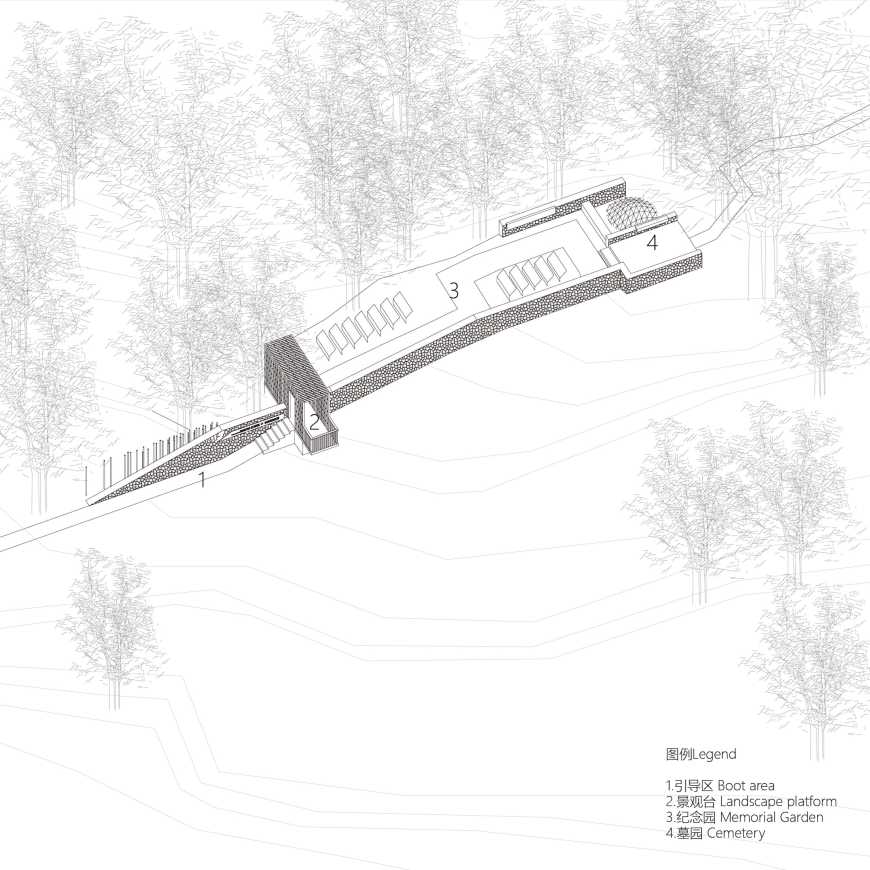 ▼空间序列关系 Spatial order
▼空间序列关系 Spatial order 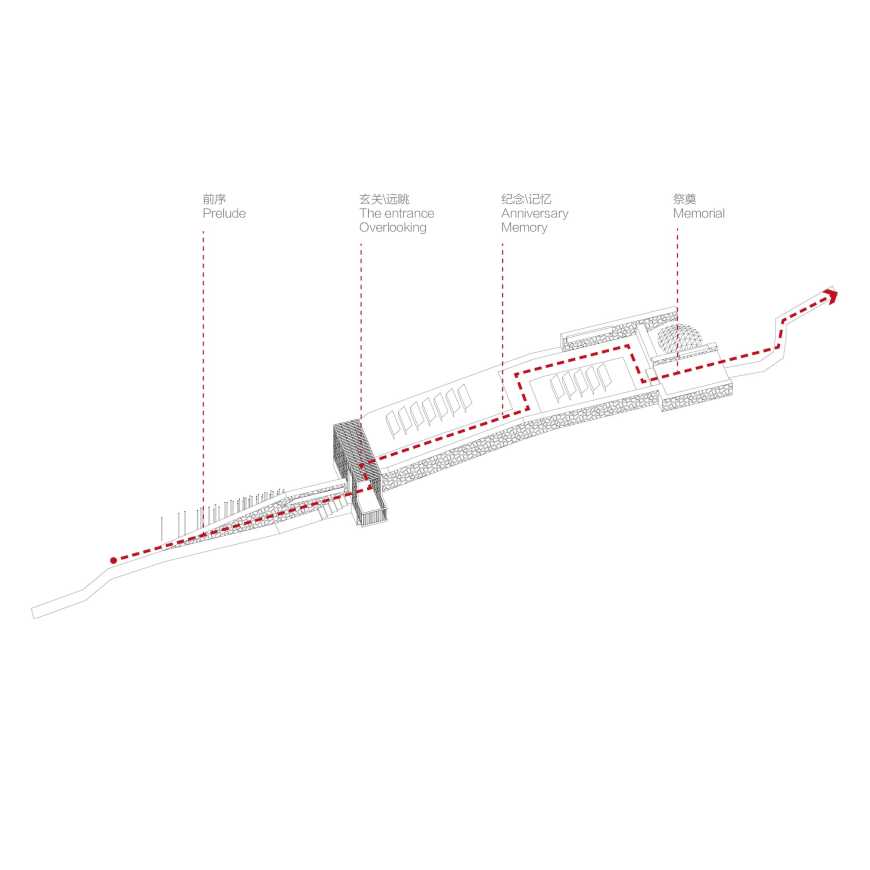
红军墓园的景观营造在最大限度的融入周边环境当中。在尺度上,通过水平方向上 的延展来体现纪念性景观的深远意义。而不是垂直方向上的宏大与压迫感的营造。在远处能够看到的墓园仅仅有钢制的景观亭露出一半。其他均掩映在山林和农田当中。方案整体为一条悠长的田间小路,串联各个景观节点, 2.5km 长的小路,并不平坦,反而有些局促难行,是红军两万五千里长征的象征,在途中设置了 18 个钢制标牌,参观者在行走中,能够看到随时间排列的长征中重要的节点事件。侯忠茂坟冢为空间高潮,暗红褐色的耐候钢制的景观亭从山坡上伸出,参观者在小路上行走时,作为视觉焦点,像一面旗帜,指引探索的方向。
The landscape design of the Red Army Cemetery aims to integrate the surrounding environment. By setting a humanistic scale, the significance of the commemorative landscape is carried out by a horizontal extension rather than creating an oppressive sense in the vertical direction. The cemetery that can be seen in a far distance is only half of the steel pavilion. Other parts are hidden in the hills and fields. The whole project has a long field path, connecting various landscape nodes. This 2.5km long road is not flat, but bumpy. It is a symbol of the Red Army’s 25,000-Li Long March. By setting 18 steel panels along the path as the signage, the visitors are able to see the important events ranked by time in the Long March. The Hou Zhongmao grave is a spatial climax. The dark reddish-brown weathering steel pavilion stretches out from the hillside. When the visitors walk on the path, they act as visual icons and banners, guiding the direction of walking.
▼纪念园入口 The Entrance of the monument
在红军墓园的设计中,仅仅用了石材和耐候钢两种材料。石材是当地最常见的材料,能够很好的融入环境当中。耐候钢在时间的作用下,呈现暗红褐色,与绿色的背景形成鲜明的对比。
走近墓园时,一道石墙贯穿整个墓地,石墙从地面开始慢慢抬起,又渐渐回到土地当中,象征着整个历史长河中的一个小小的波澜,一个年轻的生命奋斗过,但又默默的消失。入口处结合石墙的锈色钢管阵列犹如与侯忠茂一样的那些无名的红军战士,在长征的道路上献出了生命。景观亭为钢格栅组成的方形体块,从不同角度观察,能够呈现出虚、实两种状态。在树林中时隐时现,像战争中飘忽的旗帜,也像是战争中人类的命运。不同的参观者,可以有不同的理解。景观亭的高度仅仅为 2.8m,宽度为 1.2m,是适宜一人或两人停留、思考、交谈的空间。景观亭既是进入墓园的玄关,也可以在此远眺村庄,实现历史与当下的时空对话。
In the design of the Red Army Cemetery, only two materials, stone and weathering steel, were used. Stone is the most common material in the area and it can be well integrated with the context. The weathering steel has a dark reddish brown color by the time, which has a sharp contrast with the green background.
As we approaching the grave, a stone wall runs through the entire cemetery. The stone wall slowly rises from the ground and gradually returns to the ground, symbolizing a small wave in the entire historical river. A young life had ever struggled, but it disappeared silently. The rusted steel pipe array combining with the stone wall at the entrance is like the numerous unnamed Red Army soldiers, who gave their lives in the Long March. The landscape pavilion is a square block composed of steel grids. It can be seen in different states from different angles. When the pavilion dims in the woods, it likes a flag with slow wind in battle and it also represents the fate of mankind in war. Different visitors can have different understandings. The height of the landscape pavilion is only 2.8m and the width is 1.2m. It is suitable for one person or two people to stay, think and talk. The landscape pavilion is not only the entrance to the cemetery, but also the place looking to the village and forming a dialogue between history and the present.
▼景观台 The lookout platform
穿过景观亭是纪念区域,该区域结合耐候钢标牌记录了与桐梓有关的长征实践,一侧石墙上记录了小战士的事迹和相关故事,访客可以在此了解历史,回顾时光。保留的一株山桃从石墙后侧伸出,春季时候白色的花瓣随风而落,洒满小径。
最后一个空间是墓区,设计师保留了红军墓的现状,坟茔没有做任何修整,在坟墓前结合墓碑增加了一道低矮的石墙,墓碑并没有采用立式,而是横放与石墙之上,高度处于人的视线之下。后面长满荒草的坟茔与前方的新砌筑石墙墓碑形成强烈的对比,祭奠者不需要仰望,这样将先辈与世人放在同一时空,同一高度,更能让人感受到逝去的红军战士也同我们一样,曾经是鲜活的生命。
Passing through the landscape pavilion is a commemorative area, the weathering steel panels record the events in the Long March related to Tongzi. The side stone wall records the story of the young soldier and his stories. Visitors can learn about history and feel the past time. A preserved mountain peach sticks out from the back side of the stone wall. In the spring, the white petals fall with the wind and cover this small path.
The last space is the cemetery area. The designer keeps the current condition of the Red Army grave. The grave has not been trimmed. A low stone wall has been added in front of the grave combing with the tombstone. The tombstone is not vertical, but horizontally placing on the stone walls. The height is below the line of sight. The grave covering with grass has a sharp contrast with the new masonry tombstones in front. The visitors do not need to look up. This will put the ancestors and the present world in the same space and the same dimension. It will make people feel the Red Army soldiers that passed away. Like us, they used to be living life.
▼墓园 The graveyard
墓园景观中道路是比例最大的部分。路径长度约 2.5km,但主体道路宽度仅仅有 0.6m,是在村民日常穿梭 于田间的自然小路基础上改造而来,铺设了碎石和必要的台阶,其他均尊重了原貌。从局部来看,0.6m 宽的道路属于小尺度,甚至略显局促,从整体上来看, 2.5km 的散步路径,又属于大尺度,这样的长度和宽度对比,使得道路显得悠长而曲折。恰似红军长征道路的艰辛与漫长。穿梭在田间的小路四季有不同的景色变化,春季金色的油菜花盛开,夏秋田间种满玉米,游人在青纱帐中穿行,犹如体验当年行军之路。
The path in the cemetery is the largest part. The length of the path is about 2.5km, but the width is only 0.6m. It is reconstructed on the basis of the natural path that the villagers walk daily in the field. The gravel and the necessary steps are made, and the other parts have been kept as origin. From a local point of view, the 0.6m wide path is a small scale, and even slightly narrow. From a holistic point of view, the 2.5km walking path is also a large scale. It is long and tortuous. It is just like the hardship and longness of the Red Army’s Long March. There are different scenery changes in the four seasons in the field. The golden rapeseed flowers are in full bloom in the spring, and the corn is planted in the summer and autumn fields. The visitors walk through the green yarn as if they were marching in the past.
▼园区入口 The entrance of the yards
 ▼穿梭于农田中的步道 The walkway through farmland
▼穿梭于农田中的步道 The walkway through farmland ▼碎石小径与沿路纪念柱 Gravel path and memorial milestone
▼碎石小径与沿路纪念柱 Gravel path and memorial milestone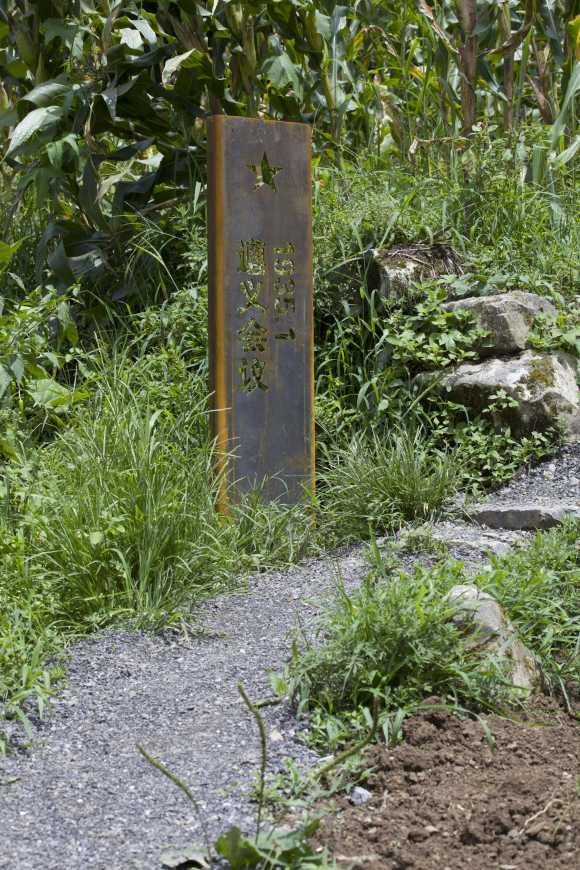
影响 Impact
红军墓建成之后,当年见过红军并守护了坟墓80年的那位老人特意前来凭吊,在红军墓前老泪纵横,外来游客也对这样一处非同寻常的“烈士陵园”带来的强烈体验表示认同。
我们试图回避此类设计的惯用的宏大叙事手法,以人的视角重新审视一位普通战士的生命痕迹,空间上没有高大的纪念碑,没有轴线对称,没有庄严肃穆,空间充满温情和思辨。以往的纪念性景观,被纪念的多数是“神”“帝王”或者某种杰出人物,即便是普通人,也常常会被蒙上“神性色彩”。而此项目中,我们纪念的是普通的红军战士,没有英雄事迹,没有爵位头衔。但他是活生生的、有血有肉的“人”,脱去了“神性”的 光彩。
曾经在这个村庄中生活过的人,他的存在其实代表的是像他一样默默无闻 为国家的和平牺牲的普通人。这正是设计师要表达关于战争中“人文主义”的理解。 尊重生命,强调每一个个体存在的价值,具有积极的进步意义。
After the completion of the Red Army Cemetery, the old man who had seen the Red Army and guarded the grave for 80 years deliberately came to visit, and he cries in front of the grave. Visitors also admit this is a different “Martyrs Cemetery” experience.
We try to avoid the usual grand narrative techniques of this kind of design, and re-examine the traces of the life of an ordinary soldier from the perspective of human beings. There are no tall monuments in space, no axis symmetry, no solemnity, and the space is full of warmth and memorial. In the past commemorative landscape design, the majority of the memorials were “God”, “Emperor” or some outstanding figure. Even ordinary people are often cast a “divine color”. In this project, we commemorate the ordinary Red Army soldiers, no heroic deeds, no title. But he is a living, bloody and fleshy “person”, taking off the brilliance of “divineness.”
The person who once lived in this village, his existence actually represents ordinary people who are as silent as he is for the peace of the country. This is exactly what designers want to express about the “humanism” of war. Respect for life, emphasize the value of each individual’s existence, and have progressive significance.
▼建成后来悼念的老人 The elder came to mourn after establishment
项目名称:贵州中关村红军墓\长征纪念园
地点:贵州遵义桐梓县茅石镇中关村
设计时间:2016.4
建成时间:2016.8
面积:170平米
主创建筑师:傅英斌
团队:张浩然、闫璐、刘洋
设计单位:傅英斌工作室(Fuyingbin Studio)\ 乡建院(CNRPD)
投资方:桐梓县人民政府
摄影:焦冬子、丁沁
Project Name: Red Army Cemetery of Zhongguan Village / Long March Memorial Park
Location: Zhongguan Village, Maoshi Town, Tongzi County, Zunyi City, Guizhou Province
Design time: 2016.4
Built in: 2016.8
Area: 170 square meters
Chief Architect: Fu Yingbin
Team: Zhang Haoran, Yan Lu, Liu Yang
Design: Fu Yingbin Studio/ CNRPD
Investor: Tongzi County People’s Government
Photography: Jiao Dongzi, Ding Qin
项目中的材料运用 Application of materials in this project
更多 Read more about: 傅英斌工作室 Fuyingbin Studio (E-mail: fuyingbin999@126.com)


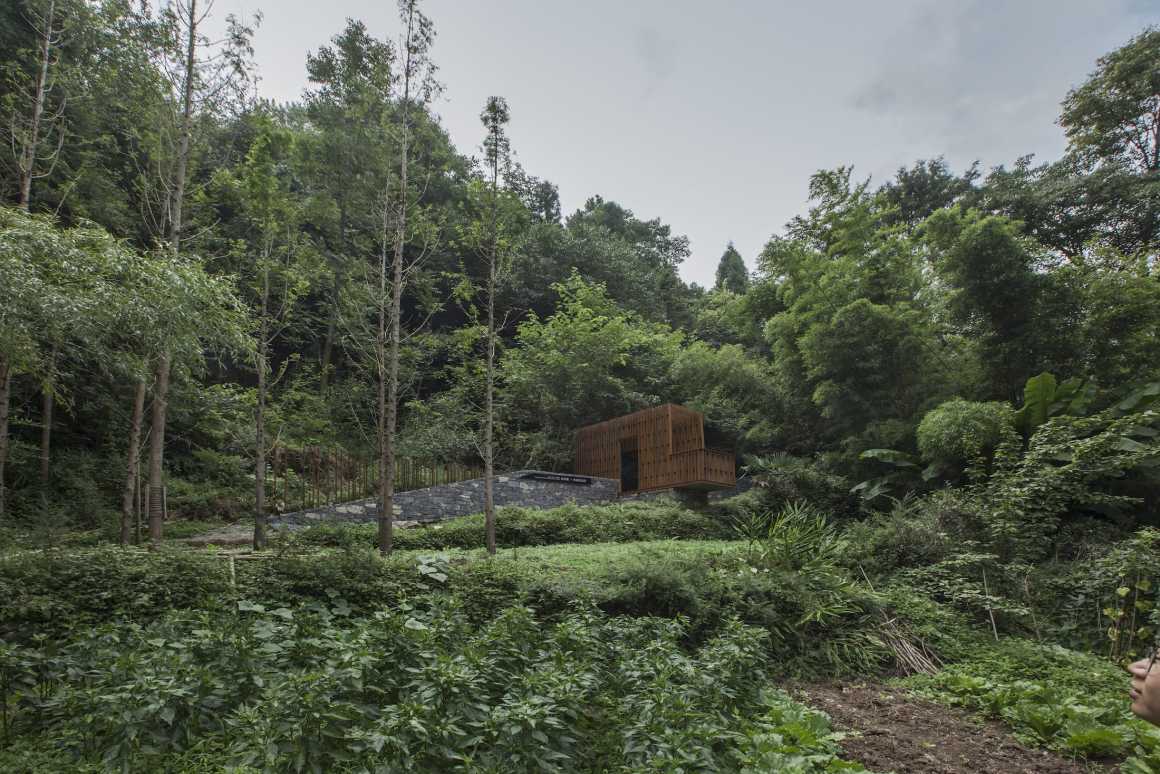
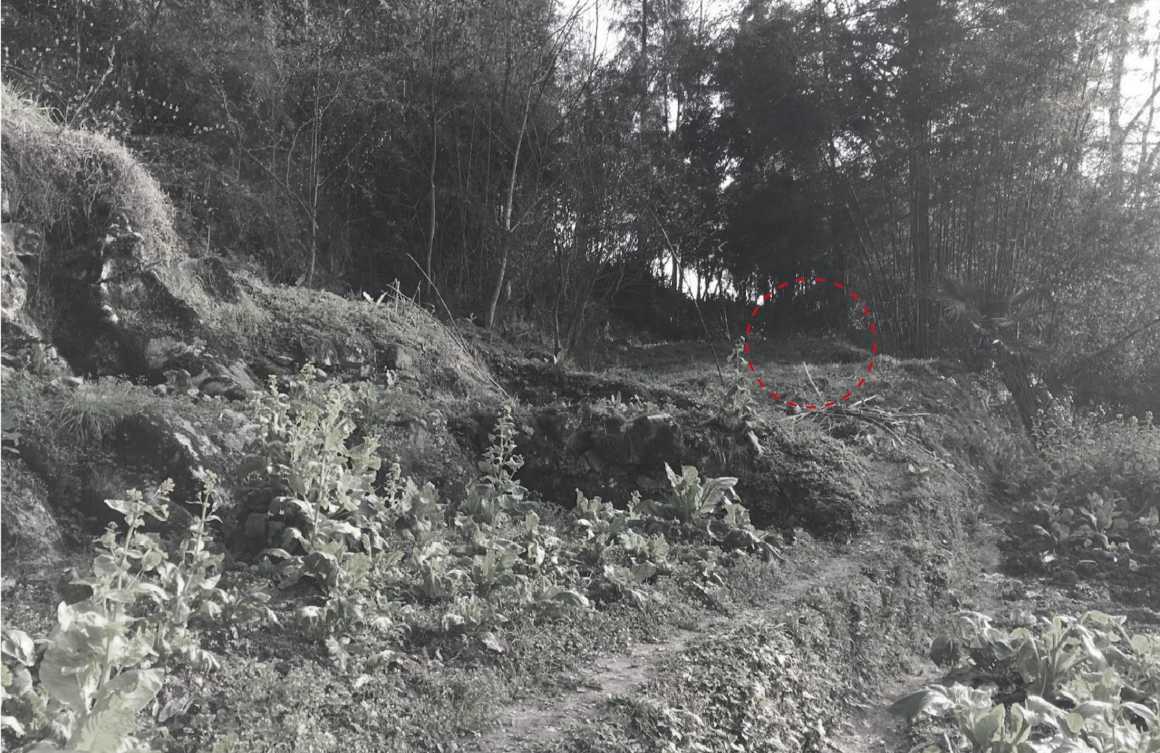


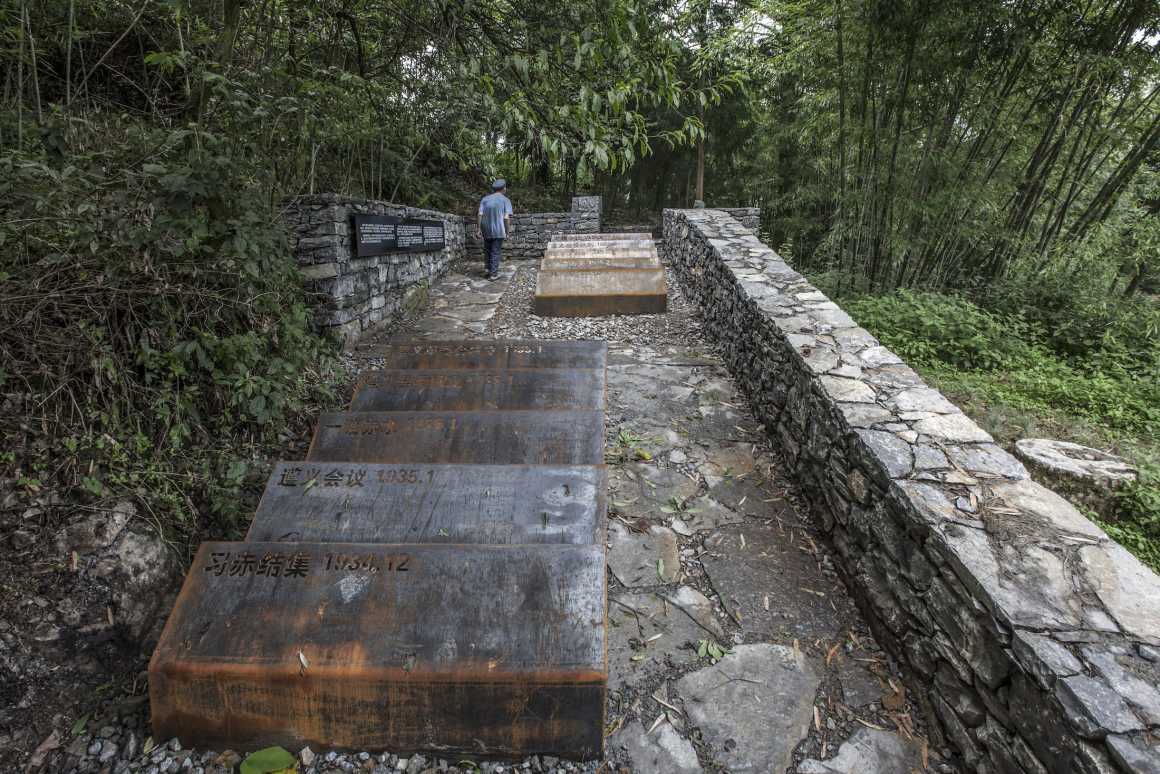

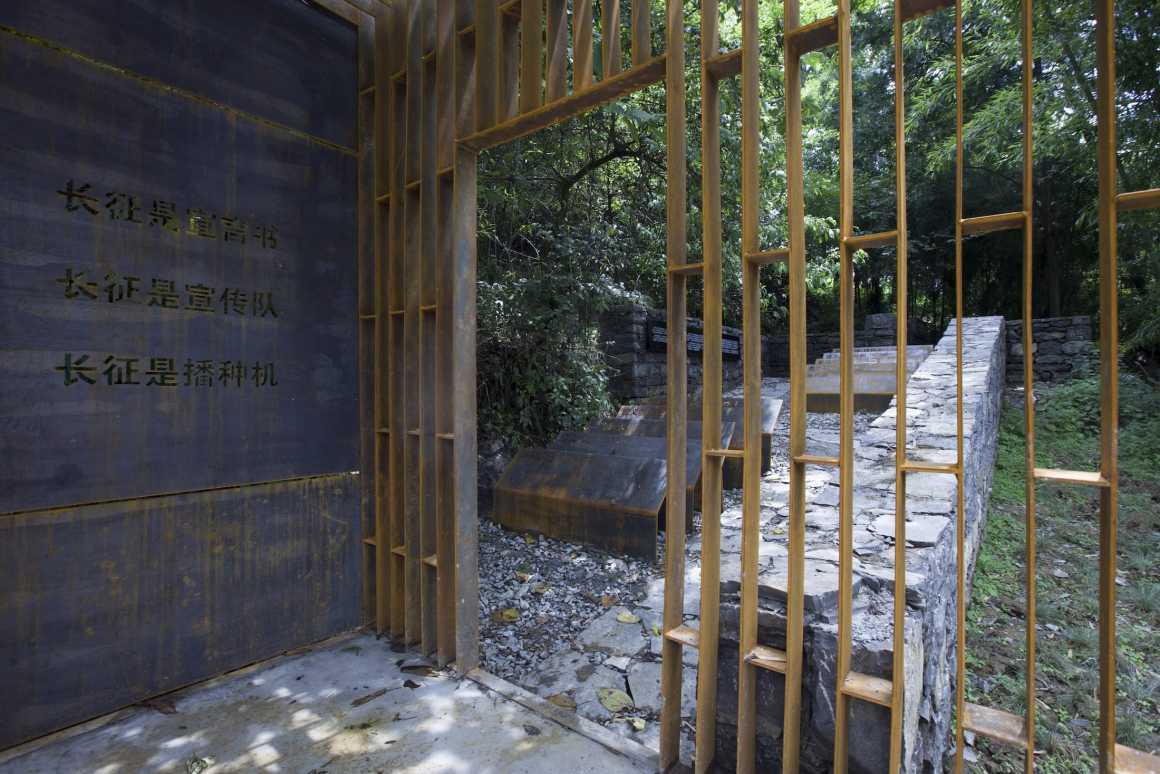
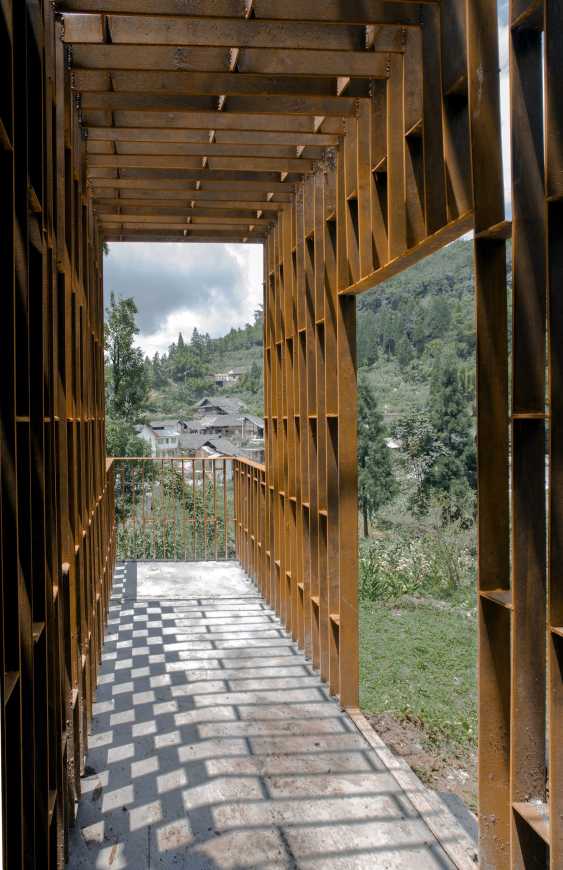

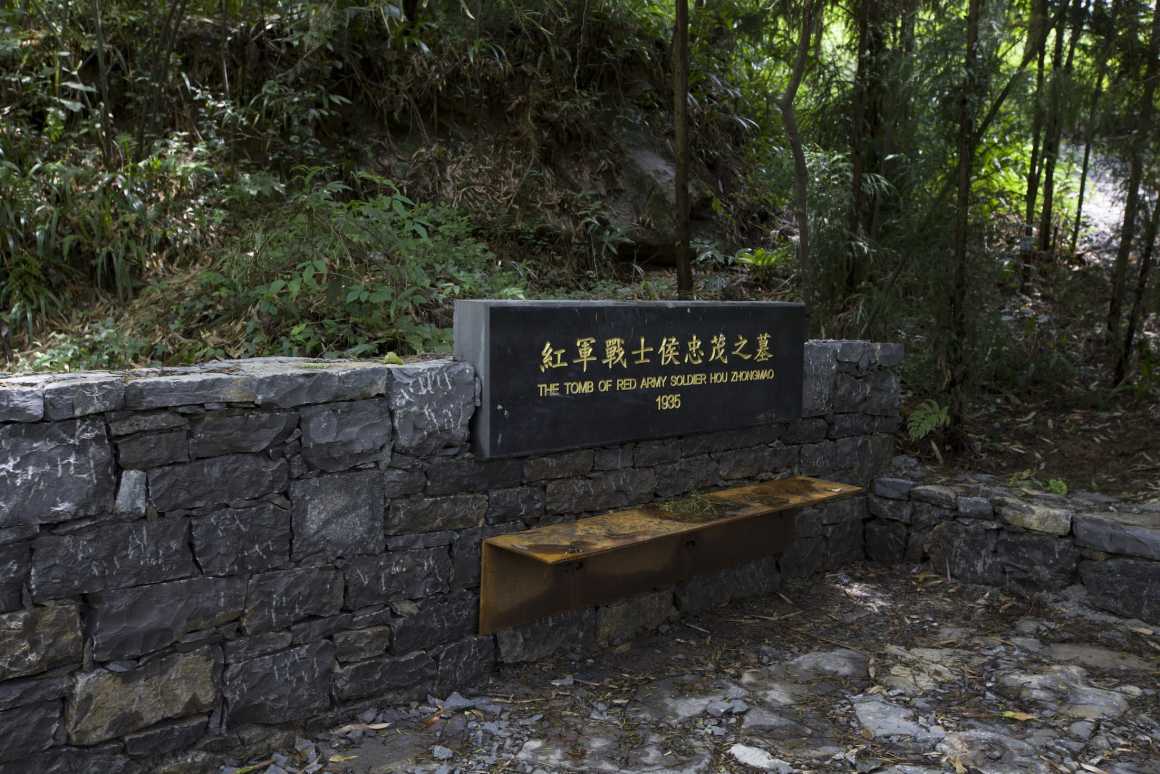
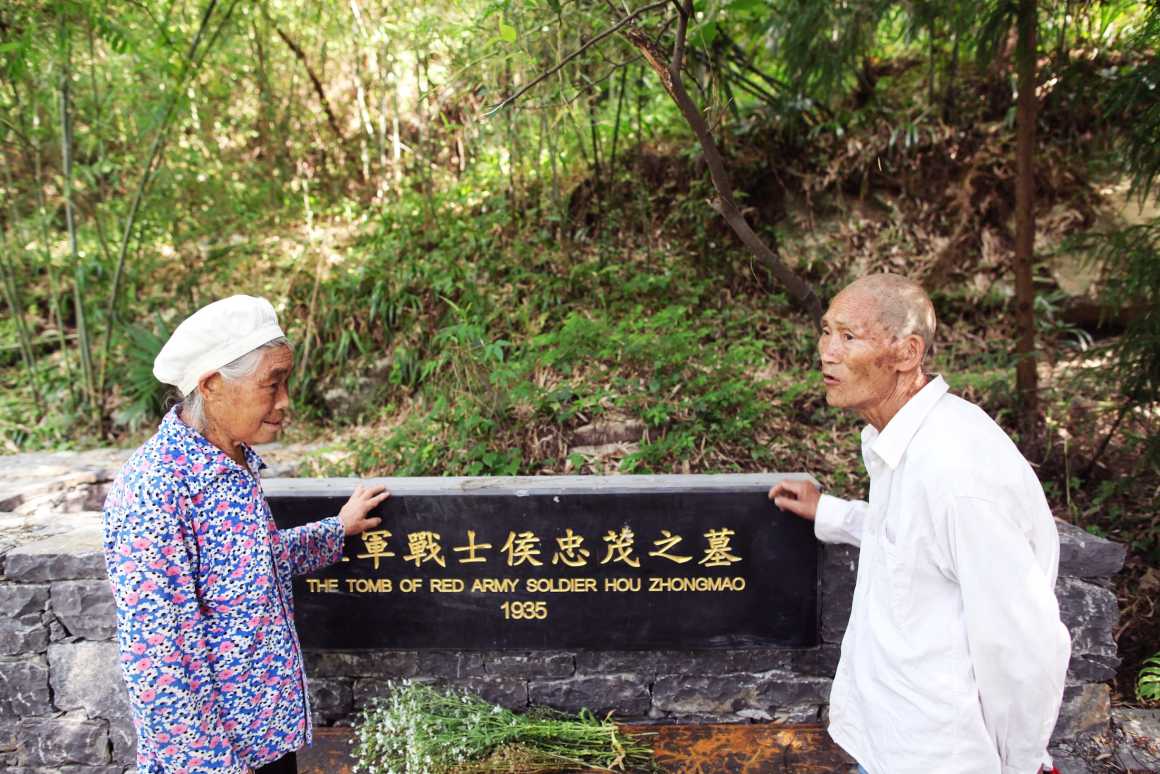
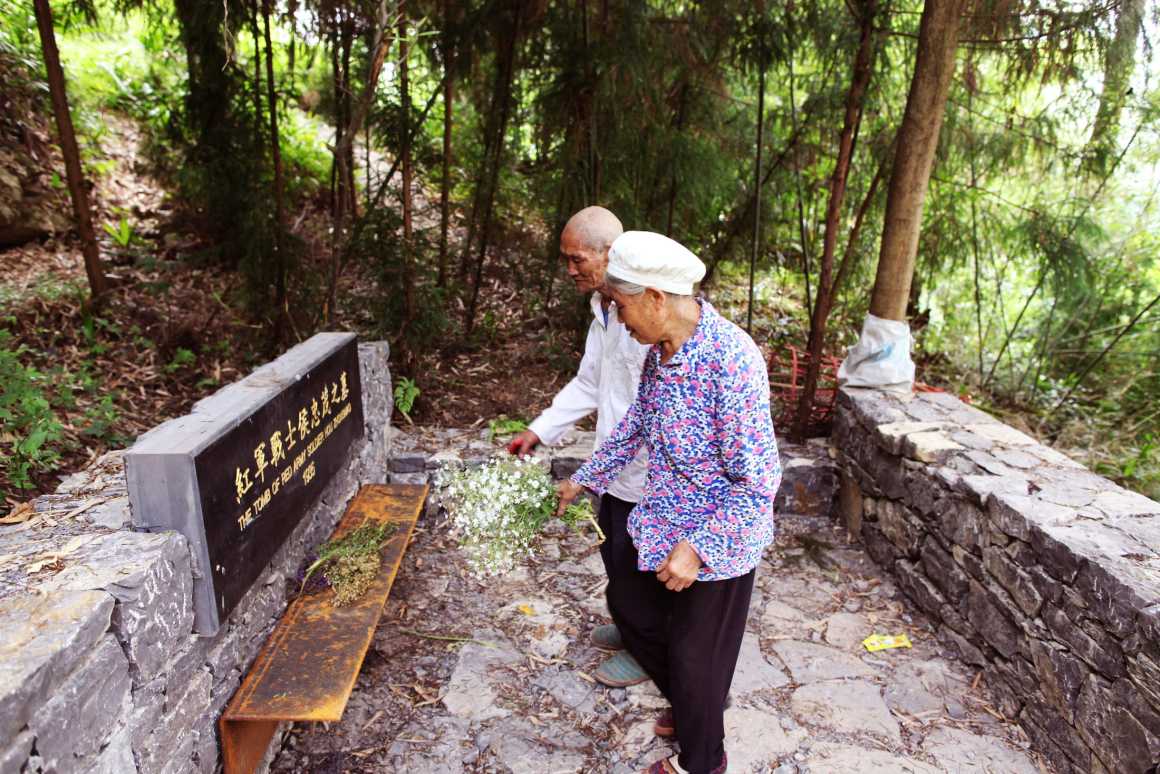


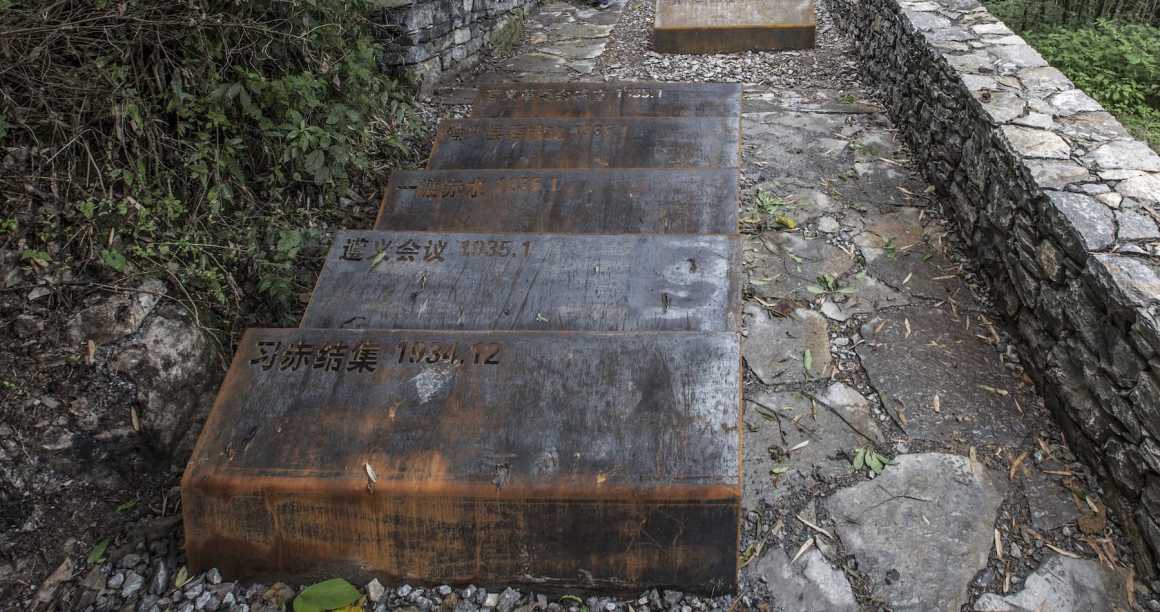


有建这个的钱,还不如都给老红军改善实际生活~~
逝去的英魂理应有好的归宿,活着的英雄国家也不曾亏待。